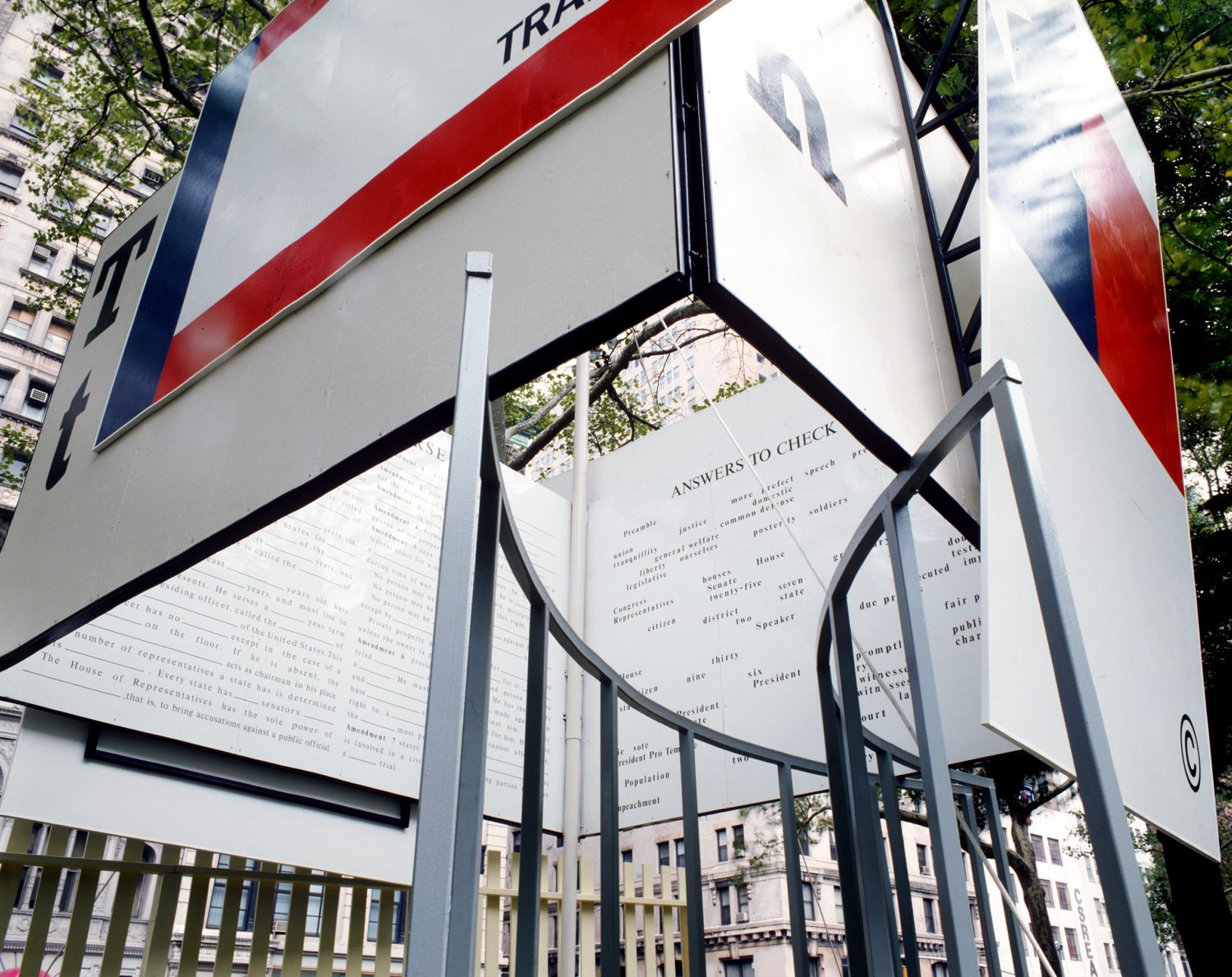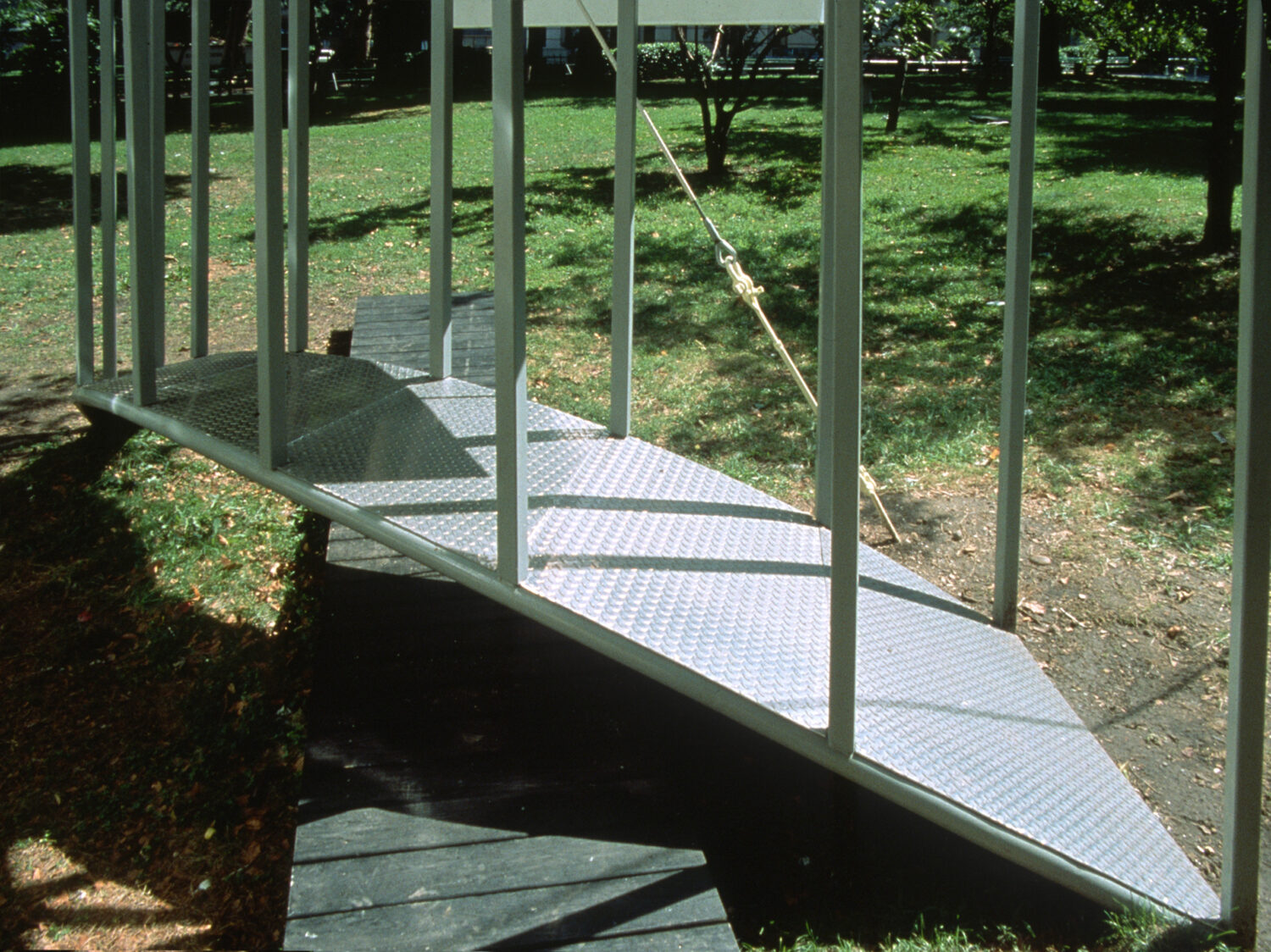
painted and welded steel, wood, aluminum, cables and rigging, vinyl signage, concrete, misc. hardware
20’ x 18’ x 52’
Liberty Prop was a collaborative project between David Schafer and architect Jeffrey Cole and was installed for one year in City Hall Park in lower Manhattan. The project was sited between the commemorative flagpole and its marker. Viewers were invited inside the pavilion to read the questions about the Constitution and Bill of Rights, which were borrowed from a high school textbook. The outer graphic images are from enlarged portions of the American flag with commercial trademarks of ownership.







Liberty Prop, 1991
City Hall Park
New York City
Public Art Fund Commission
David Schafer in collaboration with Jeffrey Cole Architect
The Quarterly Newsletter of the Public Art Fund Inc.
Fall 1991
James M. Clark
Executive Director
Walking along Broadway in Lower Manhattan, one sees a curious structure standing prominently on the grounds of City Hall Park; its heralded red, white, and blue panels promise a public ceremony or some sort of spectacle. Is it a review stand for a parade? Moving closer one sees that it’s too small for such a function. Perhaps it is a platform from which to deliver a speech? But there’s no microphone, no podium; no, this can’t be the purpose. Advertising, that’s it! It’s some sort of promotional gimmick. But, there is no corporate logo, no recognizable product name. Finally, standing next to the installation, one is immediately impressed with its dysfunctional forms: a picket fence that keeps nothing in or out; a boardwalk that goes nowhere; a bridge that is impassible.
A sign nearby reveals that this is a site-specific sculptural installation created by the collaborative team of Jeffery Cole and David Schafer. The exterior of the structure is composed of cropped sections of a 90-foot American flag arranged as advertising billboards suspended from a box-like configuration made up of flash card imagery. A boardwalk skirted by a picket fence intersects with a metal bridge at a point underneath the flag pavilion. The inquisitive may use these routes to enter and read the text inscribed on the interior panels. The text, some of which is excerpted below, is reminiscent of “fill-in-the-blank” or “question and answer” quizzes and challenges the viewer’s knowledge of the U.S. Constitution.
The billboards not only bear obvious elements of a huge, deconstructed flag, but also the markings of free enterprise: the copyright symbol, “pat. pending” and “trademark;” symbols that control a product’s usage. These universal codes of ownership and control are emblazoned on each panel, raising questions about the relationship between patriotism and capitalism. The advertising campaigns launched during the Persian Gulf War, like LIBERTY PROP, were wrapped in the American flag-marketing strategies or genuine patriotism? Underneath the “flag” billboards lie oversized flash cards, not unlike those that are used to teach children the alphabet, that together spell out “OATH.” On the flip side of the flash cards are the interior panels that bear the quiz and accompanying text on the U.S. Constitution. It is noteworthy that the core of the installation (the Constitution) is overshadowed by the symbols that have emotional appeal rather than intellectual force.
While the structure is built of uniquely American elements (the flag, the picket fence, and a boardwalk), its look is distinctly Russian Avant-Garde (1910-1930). LIBERTY PROP, in fact, alludes to Agit-Prop, the propagandistic art produced for the illiterate masses. Russian artists created theater, spectacle, and public art works that incorporated folk tradition, religious symbols and other elements readily recognizable by the masses. Here David Schafer and Jeffery Cole have continued this tradition of using familiar images and symbols to provoke questions about current social and political issues. Cole and Schafer stated that LIBERTY PROP is informed by political events, which have occurred in the Park, as well as by the Park’s commemorative statuary. Everyday, Park users pass under the watchful eye of publisher Horace Greeley, whose sculpture is sited at the northeastern entrance to the Park. Through his publications, Greeley encouraged free speech and public debate on the issues of public policy. His work influenced the public conscience of the emerging city. As Greeley did, LIBERTY PROP addresses ideas of freedom of speech, the language of democracy, and how it is dispersed throughout and accepted by the population.
Earlier in the park’s history, and just before the American Revolution, five successive Liberty Poles, erected by the Sons of Liberty, stood within City Hall Park. Each pole was erected in defiant response to the cutting down and removal of the previous pole by British soldiers. The destruction of these eventually led to further hostilities and served as a rallying point
for the rebellious sentiments, which preceded the Revolutionary War. A pole rises from one corner of the installation as a visual reference to these struggles of the pre-revolutionary era. Perhaps the public actions of the colonists informed the strategies of the Russian avant-garde.
* These poles were anathema to the British because they were cut from the white pine, a tree reserved exclusively for the masts of British war ships. Sometimes the poles were simply the branched pine, but other times colonists affixed banners or added a soft, conical cap to the crown of the pole. The cap (made famous during the French Revolution) references the caps given to freed slaves in ancient Rome.